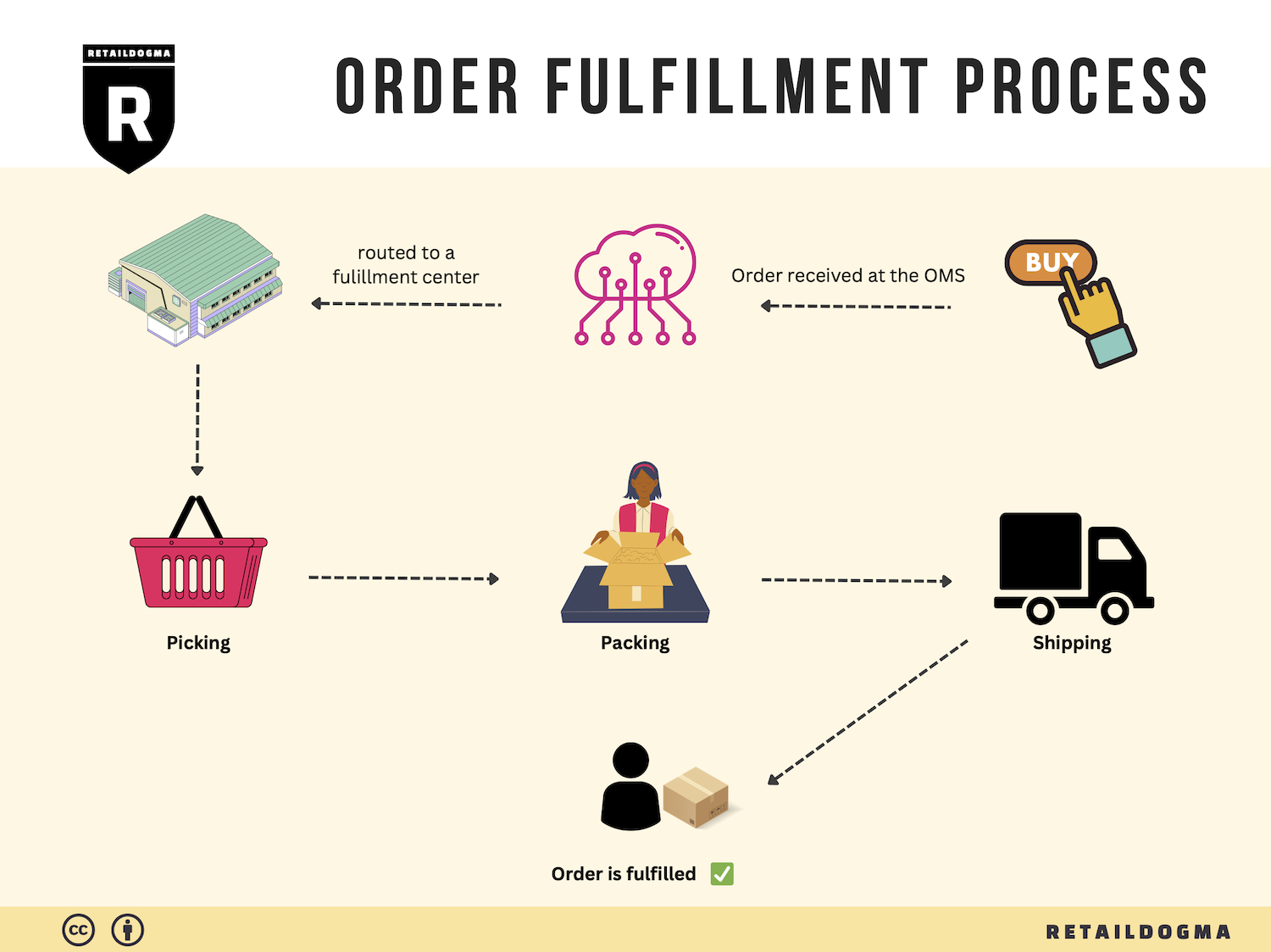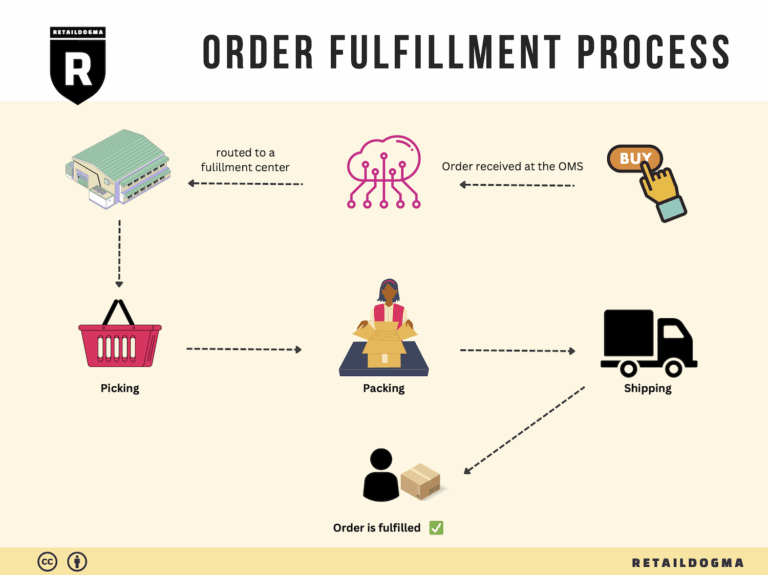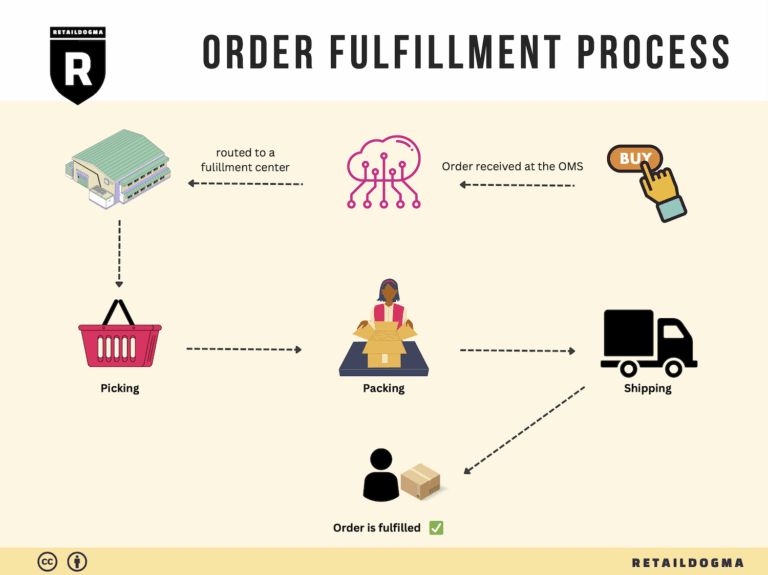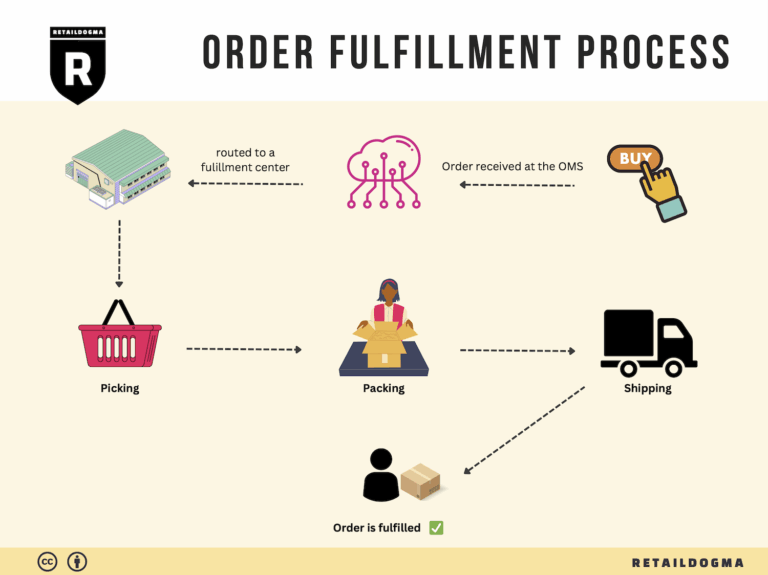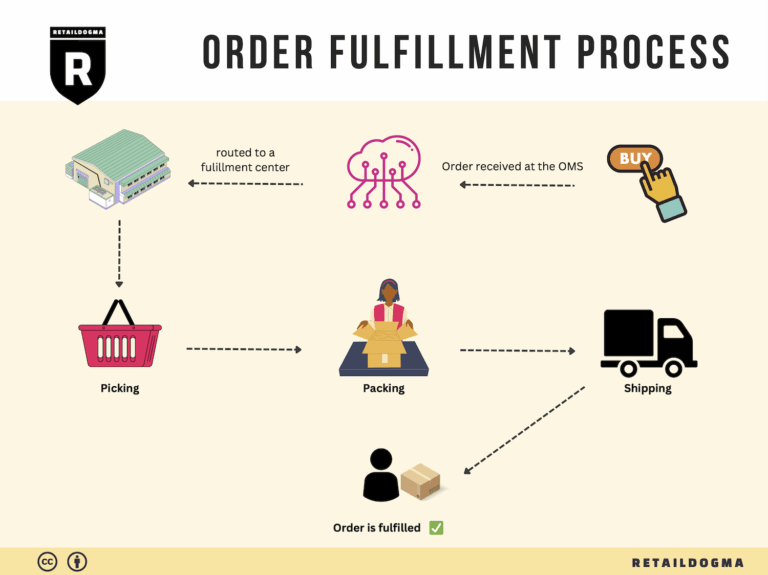What Is A Fulfillment Center? A Complete Guide (2025)
What is E-commerce Fulfillment? An Introduction for Growing Businesses
Understanding the Fulfillment Process
As an e-commerce business owner, one of the most common challenges you face is managing the overwhelming tasks of packing and shipping orders. As your sales grow, so does the complexity of fulfilling those orders efficiently and accurately. This is where e-commerce fulfillment comes into play. At its core, fulfillment is the entire process of getting a product from your inventory to your customer’s doorstep. It encompasses everything from receiving inventory to packing orders, shipping, and handling returns.
The Importance of Effective Fulfillment
Effective fulfillment is crucial for maintaining customer satisfaction and loyalty. When orders are shipped quickly and accurately, customers are more likely to return for future purchases. However, as businesses scale, handling fulfillment in-house can become burdensome. This guide aims to simplify the fulfillment landscape by exploring various fulfillment models, core services, and how to select the right logistics partner.
What This Guide Covers
In this guide, we will delve into different fulfillment models, such as Third-Party Logistics (3PL) and Fulfillment by Amazon (FBA), to help you understand the options available. We will outline the core services provided by fulfillment partners, including inventory management, order processing, shipping logistics, and returns management. Additionally, we will discuss essential criteria for selecting a fulfillment partner, including their technology capabilities, geographic reach, and service flexibility.
Making Informed Decisions
Pricing is another critical factor that will be addressed in this guide. Understanding the cost structures associated with different fulfillment services can help you make informed decisions that align with your business goals. We will provide insights on how to assess the value of fulfillment services against your operational needs and budget constraints.
Empowering Your Business
Ultimately, the goal of this guide is to empower your business to make smart decisions about logistics and fulfillment. By understanding the intricacies of the fulfillment process and the available options, you can streamline your operations, enhance customer satisfaction, and position your business for sustainable growth. Whether you are just starting or looking to scale, having a solid fulfillment strategy is essential for success in the competitive e-commerce landscape.
What You’ll Learn In This Guide
- What is E-commerce Fulfillment? An Introduction for Growing Businesses
- The Order Fulfillment Process: From ‘Buy’ Button to Customer’s Door
- Comparing Fulfillment Models: In-House vs. 3PL vs. Dropshipping
- A Deep Dive into Amazon FBA: Pros, Cons, and Who It’s For
- Core Services Offered by Fulfillment Centers
- How to Choose a Fulfillment Partner: A 6-Point Checklist
- Understanding Fulfillment Pricing: A Breakdown of Common Fees
- Frequently Asked Questions (FAQs) about Fulfillment
- Conclusion: Is Outsourcing Fulfillment the Right Move for Your Business?
- Important Disclaimer
The Order Fulfillment Process: From ‘Buy’ Button to Customer’s Door
1. Receiving Inventory
The first step in the order fulfillment process is receiving inventory. This involves the acceptance of goods into your warehouse or fulfillment center. Upon arrival, the inventory is checked against the purchase order to ensure accuracy in quantity and quality. This step is crucial as it lays the foundation for effective inventory management and ensures that the products are in good condition for sale.
A key term associated with this step is SKU (Stock Keeping Unit), which is a unique identifier for each product. Properly managing SKUs during the receiving process helps in organizing inventory and streamlining subsequent steps in fulfillment. Implementing a robust receiving process also reduces discrepancies, minimizes returns, and enhances overall customer satisfaction.
2. Warehouse Storage
Once the inventory is received and verified, the next step is warehouse storage. This involves placing the products in designated areas within the fulfillment center. Proper storage is vital for maintaining an organized inventory system and ensuring that items are easily accessible for order fulfillment.
The concept of bin locations comes into play here, as it refers to specific areas designated for particular SKUs. By utilizing bin locations, businesses can optimize their storage space and improve picking efficiency. An organized storage system not only facilitates faster order processing but also aids in inventory tracking and management, reducing the risk of stockouts or overstock situations.
3. Order Picking
Order picking is the process of retrieving items from storage to fulfill a customer order. This step is critical because the speed and accuracy of picking directly affect order turnaround times and customer satisfaction. A well-implemented picking process can significantly reduce the time taken from order placement to dispatch.
During this phase, pick lists are generated, which provide details of the items to be retrieved, including their locations and quantities. There are various picking methods, such as batch picking, wave picking, or zone picking, each suited for different business needs. Efficient order picking not only ensures that customers receive the correct items promptly but also optimizes labor costs and increases warehouse efficiency.
4. Order Packing
Once the items are picked, they move to the packing stage. Order packing involves assembling the items into a package, preparing them for shipment. This step is essential for ensuring that products are securely packaged to prevent damage during transit.
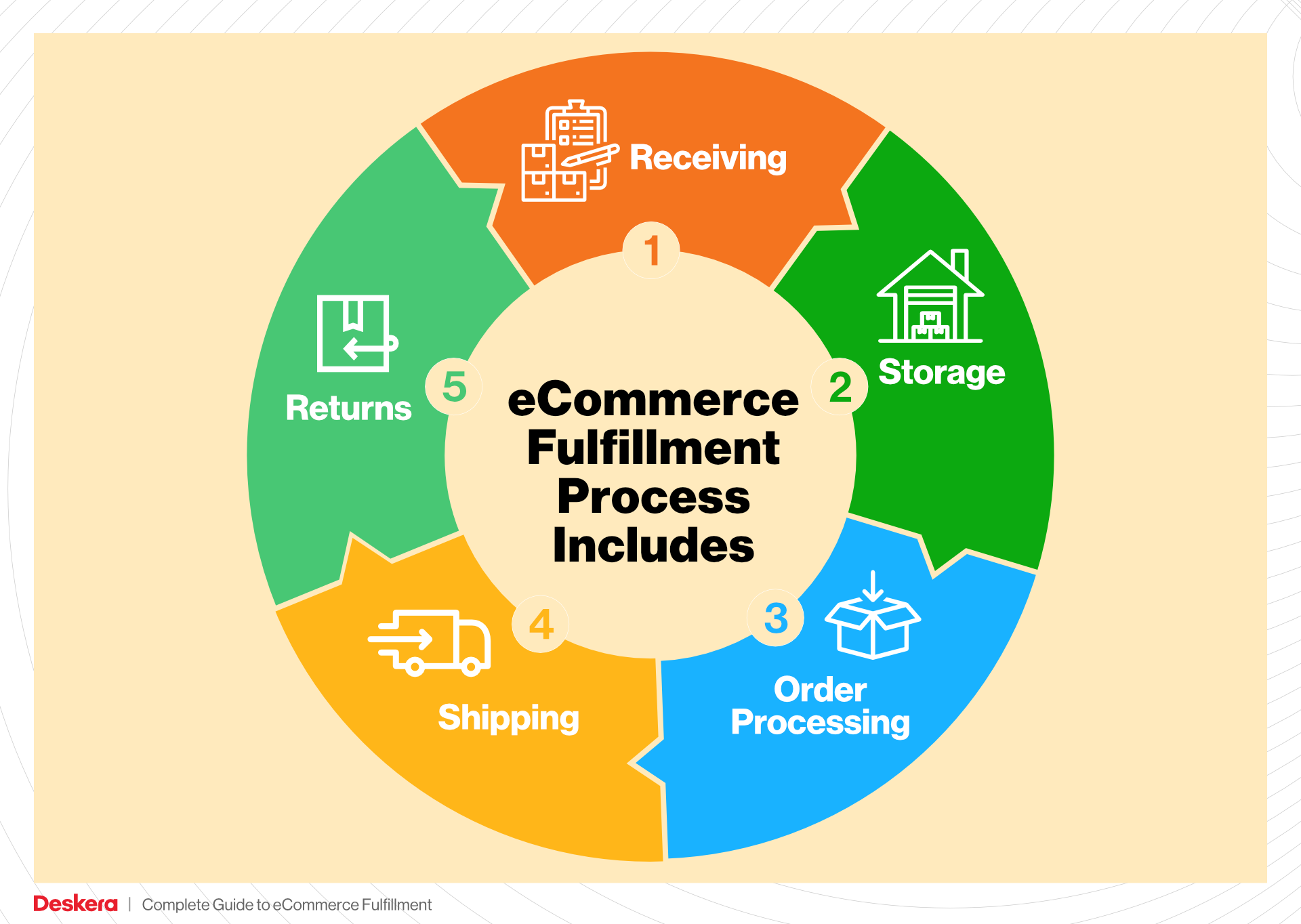
Key considerations in the packing process include packaging materials and dimensional weight pricing. Using the right packaging materials (such as bubble wrap, boxes, or padded envelopes) protects the items, while understanding dimensional weight pricing helps in optimizing shipping costs. Effective packing not only reduces shipping expenses but also enhances the unboxing experience for customers, reinforcing brand loyalty.
5. Shipping & Delivery
The final step in the order fulfillment process is shipping and delivery. This involves transferring the packed orders to the chosen carrier for distribution to the customer. The efficiency of this step can significantly influence customer satisfaction and retention.
A critical term in this phase is last-mile delivery, which refers to the final leg of the shipping journey from the distribution center to the customer’s doorstep. Selecting the right shipping partners and delivery options is essential for ensuring timely delivery. Offering various shipping methods, such as express or standard shipping, can cater to different customer preferences and improve overall fulfillment performance. Additionally, utilizing tracking systems allows customers to monitor their order status, enhancing transparency and trust in the fulfillment process.
In conclusion, mastering the order fulfillment process from receiving inventory to shipping and delivery is crucial for scaling e-commerce operations. Each step requires careful planning and execution to ensure that businesses can meet customer expectations efficiently while minimizing costs and maximizing satisfaction.
Comparing Fulfillment Models: In-House vs. 3PL vs. Dropshipping
Fulfillment Model Comparison Table
| Model | Who Handles Inventory | Best For (Business Stage) | Key Advantage | Key Disadvantage |
|---|---|---|---|---|
| In-House Fulfillment | The business itself | Established businesses with stable demand | Full control over inventory and processes | High overhead costs and resource commitment |
| Third-Party Logistics (3PL) | A third-party logistics provider | Startups and growing businesses | Scalable solutions and reduced overhead | Less control over logistics and inventory |
| Dropshipping | Supplier or manufacturer | New businesses or niche markets | Low upfront investment and risk | Lower profit margins and reliance on suppliers |
In-House Fulfillment
In-house fulfillment involves managing the entire logistics process within the business itself. This model is typically favored by established companies with stable demand and sufficient resources to handle inventory, warehousing, and shipping. With in-house fulfillment, businesses have complete control over their inventory, allowing for tailored processes that align with their brand standards and customer service expectations. This control can enhance product quality, improve turnaround times, and enable personalized customer experiences. However, this model comes with significant drawbacks, including high overhead costs related to maintaining warehouse space, staffing, and technology investments. Additionally, as the business scales, managing logistics can become increasingly complex and resource-intensive, which may divert focus from core business operations.
Third-Party Logistics (3PL)
Third-party logistics (3PL) providers offer outsourced logistics services, encompassing everything from warehousing to shipping. This model is ideal for startups and growing businesses that may not have the capital or resources to invest in in-house fulfillment. By partnering with a 3PL, companies can leverage the provider’s expertise, technology, and scalable solutions, allowing them to focus on their core competencies such as product development and marketing. 3PLs often have extensive networks of warehouses and distribution centers, enabling faster shipping and broader market reach. However, one of the key disadvantages is the reduced control over logistics and inventory management. Businesses must trust their 3PL to maintain quality and efficiency, which can lead to issues if the provider does not meet expectations. Additionally, while 3PLs can be cost-effective, variable pricing structures may lead to higher costs as businesses grow or face fluctuations in demand.
Dropshipping
Dropshipping is a fulfillment model where the retailer does not keep products in stock but instead transfers customer orders directly to a supplier or manufacturer, who then ships the products directly to the customer. This model is particularly well-suited for new businesses and entrepreneurs venturing into niche markets, as it requires minimal upfront investment and inventory risk. Retailers can offer a wide range of products without the burden of managing inventory or logistics, allowing them to test new markets and products with lower financial commitment. However, dropshipping also comes with significant downsides. Profit margins are typically lower compared to other models since retailers pay wholesale prices while selling at retail. Additionally, reliance on suppliers for inventory and shipping can lead to inconsistencies in product quality and delivery times, which can negatively impact customer satisfaction and brand reputation. Retailers also have limited control over the fulfillment process, which can complicate customer service and returns management.
Conclusion
Choosing the right fulfillment model is crucial for e-commerce businesses aiming to scale their operations effectively. Each model—In-House Fulfillment, Third-Party Logistics (3PL), and Dropshipping—offers unique advantages and challenges that must align with a business’s specific needs, resources, and growth strategies. Understanding these differences can empower business owners and operations managers to make informed decisions that support their logistical and operational goals while enhancing customer satisfaction.
A Deep Dive into Amazon FBA: Pros, Cons, and Who It’s For
Understanding Fulfillment by Amazon (FBA)
Fulfillment by Amazon (FBA) is a service that allows e-commerce sellers to store their products in Amazon’s fulfillment centers. Amazon takes care of storage, packaging, and shipping, as well as handling customer service and returns. This service has gained immense popularity among sellers on Amazon and beyond, providing an efficient way to manage logistics while leveraging Amazon’s vast marketplace.
How FBA Works
-
Setting Up: Sellers create an Amazon seller account and choose FBA as their fulfillment method. They prepare their products according to Amazon’s guidelines and ship them to Amazon’s warehouses.
-
Storage: Once the products arrive at the fulfillment centers, Amazon stores them until they are sold. Sellers can monitor their inventory levels through the Amazon Seller Central dashboard.
-
Order Fulfillment: When a customer places an order, Amazon picks, packs, and ships the product on behalf of the seller. This process ensures that customers receive their orders promptly, often with options for same-day or two-day delivery through Amazon Prime.
-
Customer Service: Amazon handles all customer service inquiries related to FBA products, including returns and refunds, which allows sellers to focus on growing their business.
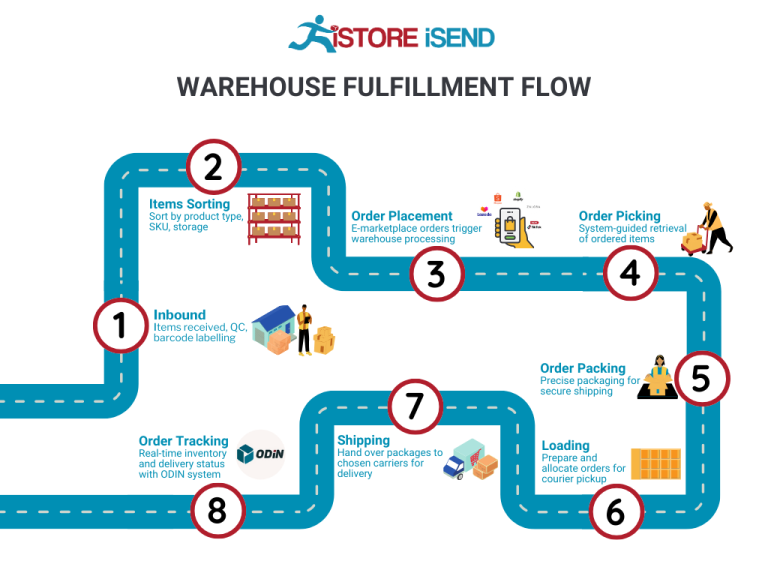
-
Multi-Channel Fulfillment: Sellers can also use FBA to fulfill orders from other sales channels outside of Amazon, such as their own websites or other online marketplaces. This service streamlines logistics across different platforms.
Pros of Using FBA
1. Prime Eligibility
One of the significant advantages of FBA is that products become eligible for Amazon Prime. This membership program offers customers fast shipping options, which can lead to higher sales and increased customer loyalty. Prime members often prefer to purchase products that come with the Prime badge, making FBA an attractive option for sellers.
2. Customer Trust
Leveraging Amazon’s reputation can significantly enhance seller credibility. Products fulfilled by Amazon come with the assurance of quality service, including reliable shipping and customer support. Buyers are more likely to trust and purchase products that are backed by Amazon’s fulfillment services.
3. Multi-Channel Fulfillment
FBA allows sellers to manage inventory across multiple platforms seamlessly. This flexibility means that sellers can sell on Amazon while also fulfilling orders from their own websites or other marketplaces, all through the same inventory stored at Amazon’s facilities. This integration simplifies logistics and helps maintain consistent inventory levels.
4. Simplified Logistics
By outsourcing fulfillment to Amazon, sellers can focus more on their core business activities, such as product development and marketing. FBA handles the complexities of storage, shipping, and customer service, reducing the operational burden on sellers.
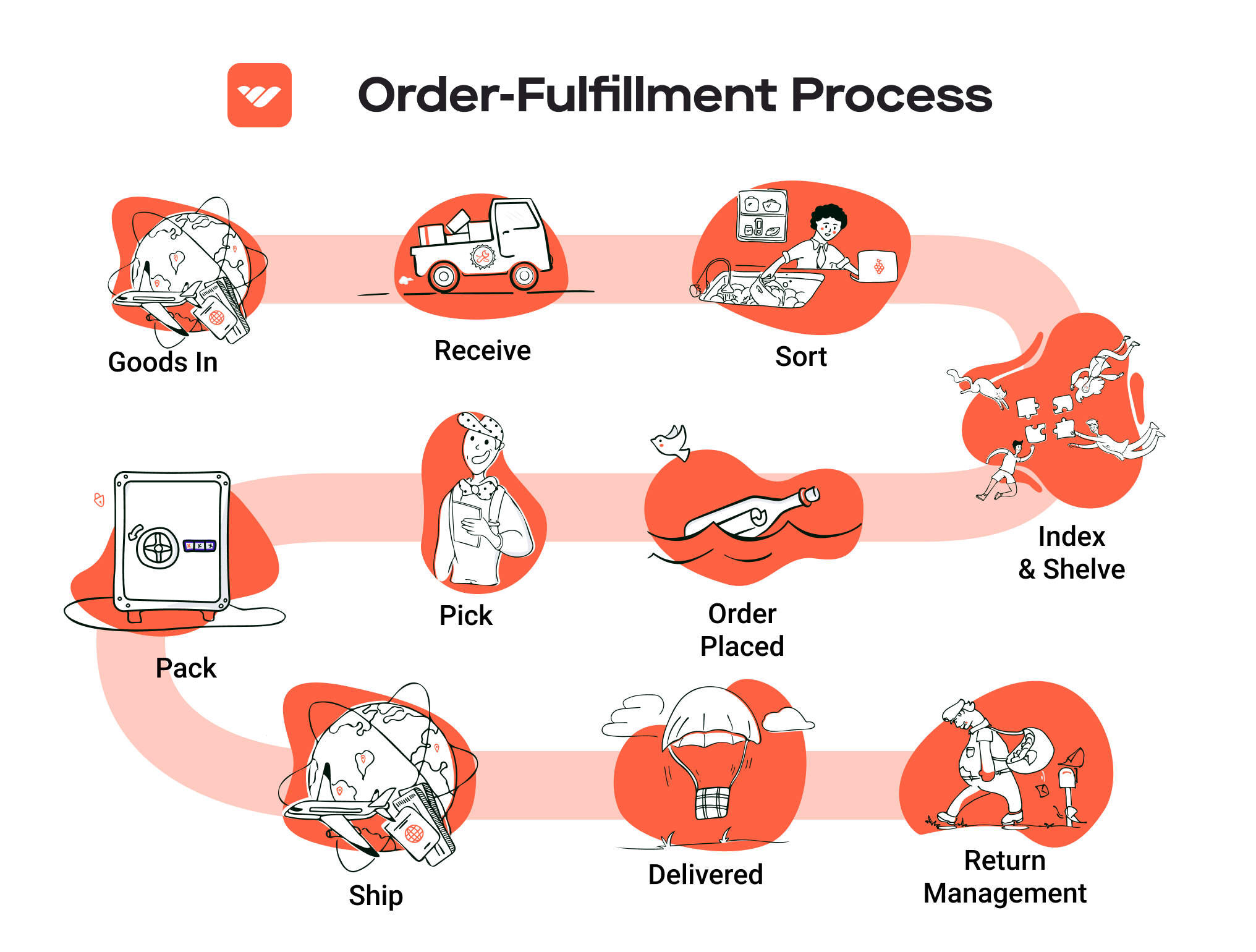
5. Scalability
FBA provides a scalable solution for growing businesses. Sellers can easily increase their inventory without the need for additional warehouse space or staffing, allowing them to respond quickly to market demands.
Cons of Using FBA
1. High Fees
One of the main drawbacks of FBA is the cost. Sellers incur various fees, including storage fees for keeping inventory in Amazon’s warehouses and fulfillment fees for each unit sold. These costs can quickly add up, particularly for low-margin products, potentially eating into profits.
2. Strict Inventory Rules
Amazon imposes strict guidelines regarding inventory management, including limits on the amount of inventory a seller can store based on their sales history. This can be challenging for sellers with fluctuating demand or seasonal products, as they may face stockouts or additional fees for excess inventory.
3. Commingling Risks
FBA products can be commingled, meaning that inventory from multiple sellers is stored together. While this can streamline operations, it poses a risk for sellers if their products are damaged or if counterfeit items are mixed in. If a seller’s item is returned or reported, they may face challenges proving the authenticity of their products.
4. Loss of Control
Outsourcing fulfillment means that sellers relinquish some control over the logistics process. This lack of direct oversight can lead to issues with shipping times, inventory accuracy, and customer service, which may not align with a seller’s brand standards.
5. Dependency on Amazon
Relying on FBA can create a dependency on Amazon’s platform. Any changes to Amazon’s policies, fees, or algorithms can significantly impact a seller’s business. This dependency can be risky, especially for businesses looking to diversify their sales channels.
Who is FBA Best For?
FBA is particularly beneficial for small to medium-sized e-commerce businesses that want to leverage Amazon’s extensive logistics network without investing heavily in their own fulfillment infrastructure. It is ideal for:
- Sellers with High Volume: Businesses that sell large quantities of products can benefit from the economies of scale that FBA offers.
- Brands Looking for Exposure: New or emerging brands seeking to establish credibility and reach a wider audience can gain visibility through Amazon’s marketplace.
- Businesses with Limited Resources: Companies that lack the resources or expertise to manage logistics and customer service can focus on growth while outsourcing these functions to Amazon.
- Multi-Channel Sellers: Businesses that sell across various platforms can simplify their fulfillment processes through FBA, ensuring a consistent customer experience.
In conclusion, FBA provides a powerful solution for e-commerce sellers looking to streamline operations and enhance customer trust. However, it is essential for business owners to weigh the pros and cons carefully to determine if it aligns with their operational goals and profit margins.
Core Services Offered by Fulfillment Centers
Inventory Management & Warehousing
Inventory management and warehousing are foundational elements of any fulfillment center’s offerings. This service involves the systematic tracking of inventory levels, orders, sales, and deliveries, alongside the physical storage of goods in a warehouse.
What It Is: Fulfillment centers utilize sophisticated inventory management systems to monitor stock levels in real time. They employ various technologies, such as barcode scanning and RFID (Radio Frequency Identification), to ensure accurate tracking and management of inventory. Warehousing facilities are strategically located to minimize shipping times and costs, providing businesses with easy access to their products.
Benefits for E-Commerce Businesses:
-
Optimized Stock Levels: By maintaining accurate inventory records, businesses can avoid stockouts or overstock situations, ensuring that they meet customer demand without tying up excessive capital in unsold goods.
-
Improved Order Fulfillment Speed: With strategically located warehouses, fulfillment centers can ship products faster, enhancing customer satisfaction and potentially increasing repeat purchases.
-
Cost Efficiency: Outsourcing inventory management and warehousing to a fulfillment center can reduce overhead costs associated with maintaining a dedicated warehouse and staff, allowing businesses to scale without significant investment in infrastructure.
Pick and Pack Services
Pick and pack services are integral to the order fulfillment process. This involves selecting items from inventory (picking) and preparing them for shipment (packing) based on customer orders.
What It Is: Fulfillment centers employ trained staff and automated systems to efficiently pick items from shelves and pack them according to specific guidelines. This may include using appropriate packaging materials, labeling, and ensuring that items are secure for transport.
Benefits for E-Commerce Businesses:
-
Efficiency and Accuracy: Professional pick and pack services streamline the order processing workflow, reducing errors in order fulfillment. This accuracy is critical for maintaining customer trust and satisfaction.
-
Scalability: As e-commerce businesses grow, the volume of orders can increase significantly. Fulfillment centers can easily scale their pick and pack operations to handle fluctuating order volumes without requiring businesses to hire additional staff.
-
Custom Packaging Options: Many fulfillment centers offer customizable packing solutions, including branded packaging and gift-wrapping services. This enhances the customer experience and can differentiate a brand in a competitive market.
Kitting and Assembly
Kitting and assembly services involve the pre-assembly of products or the bundling of multiple items into a single package before shipping.
What It Is: This service allows businesses to combine various products into a single kit or assemble components into a final product. This is particularly useful for businesses selling products that are frequently purchased together or require assembly before use.
Benefits for E-Commerce Businesses:
-
Enhanced Product Offerings: Kitting can create bundled products that appeal to customers, potentially increasing average order value and sales. For example, a beauty brand might bundle a skincare routine into a single kit, making it easier for customers to purchase.
-
Time Savings: By outsourcing kitting and assembly, businesses can save time and resources, allowing them to focus on core operations such as marketing and customer service. Fulfillment centers can efficiently handle complex assembly tasks that may be labor-intensive.
-
Increased Operational Flexibility: Kitting services provide businesses with the flexibility to introduce limited-time offers or seasonal promotions quickly. This adaptability can enhance responsiveness to market trends and customer preferences.
Returns Management (Reverse Logistics)
Returns management, often referred to as reverse logistics, is a critical service offered by fulfillment centers to handle the return process of products.
What It Is: This service involves managing the return of products from customers back to the fulfillment center. It includes processes such as inspecting returned items, restocking, and managing refunds or exchanges.
Benefits for E-Commerce Businesses:
-
Streamlined Returns Process: An efficient returns management system simplifies the process for customers, making it easier for them to return items. This enhances customer satisfaction and can encourage future purchases, even if an initial order was returned.
-
Cost Recovery: By effectively managing returns, fulfillment centers can help businesses recover costs associated with returned items. This includes determining if products can be restocked, repaired, or require liquidation.
-
Data Insights: Returns management provides valuable insights into customer behavior and product performance. Understanding the reasons behind returns can help businesses refine their product offerings and improve overall customer satisfaction.
In conclusion, fulfillment centers provide a suite of core services that are essential for e-commerce businesses looking to scale efficiently. By leveraging these services, businesses can enhance their operational efficiency, improve customer satisfaction, and ultimately drive growth in a competitive marketplace.
How to Choose a Fulfillment Partner: A 6-Point Checklist
Location & Warehouse Network
The geographical location of your fulfillment partner’s warehouses can significantly affect shipping times and costs. A strategically positioned network allows for faster deliveries and lower transportation expenses, which are crucial for maintaining customer satisfaction and optimizing profit margins.
Key Questions to Ask:
– Where are your warehouses located?
– How many fulfillment centers do you operate, and what is the coverage area?
– Do you have facilities in key markets where I plan to sell my products?
Technology & Integrations
In today’s digital landscape, the technology used by a fulfillment partner can make or break your operations. An effective 3PL provider should offer robust technology solutions that integrate seamlessly with your existing e-commerce platforms (like Shopify, Amazon, etc.) and provide real-time tracking, inventory management, and analytics.
Key Questions to Ask:
– What kind of technology and software do you use for order processing and inventory management?
– Can you integrate with my existing e-commerce platforms? What are the steps involved?
– Do you offer real-time tracking for shipments and inventory levels?
Specializations (e.g., Cold Storage, Oversized Items)
Not all fulfillment partners are created equal, especially when it comes to handling specific types of products. If your business deals with special requirements—such as cold storage for perishables or oversized items—ensure your partner has the necessary capabilities and experience.
Key Questions to Ask:
– What special services do you offer (e.g., cold storage, hazardous materials handling)?
– Can you accommodate unique packaging or shipping requirements?
– Do you have experience with businesses in my industry or with similar products?
Scalability & Capacity
As your business grows, your fulfillment needs will evolve. A capable partner should not only meet your current demands but also scale with your business. Assess their capacity to handle fluctuations in order volume, especially during peak seasons.
Key Questions to Ask:
– What is your current capacity, and how do you manage peak season surges?
– Can you provide examples of how you’ve scaled operations for clients in the past?
– How flexible is your model in terms of increasing or decreasing services based on my needs?
Pricing and Contracts
Understanding the pricing structure and terms of engagement is crucial to maintaining profitability. Look for transparency in pricing, including any hidden fees related to storage, order processing, or shipping. Contracts should be flexible enough to accommodate changes in your business dynamics.
Key Questions to Ask:
– Can you provide a detailed breakdown of your pricing structure?
– Are there any additional fees I should be aware of (e.g., for returns, storage, or seasonal fluctuations)?
– What are the terms of the contract? Is there flexibility for renegotiation?
Customer Support & Reviews
Customer support can significantly impact your experience with a fulfillment partner. Responsive and knowledgeable support can quickly resolve issues that arise, ensuring your operations run smoothly. Additionally, checking reviews and testimonials can provide insight into their reliability and service quality.
Key Questions to Ask:
– What kind of customer support do you offer? Is it available 24/7?
– Can you provide references or case studies from current or past clients?
– How do you handle issues or discrepancies in orders?
Conclusion
Choosing the right fulfillment partner is a critical decision that can influence your e-commerce business’s efficiency and customer satisfaction. By following this checklist, you can make a well-informed choice that aligns with your operational needs and growth objectives. Always remember to conduct thorough due diligence, ask the right questions, and seek partners who are willing to adapt to your unique requirements. This proactive approach will set the foundation for a successful partnership that supports your business’s scalability and profitability.
Understanding Fulfillment Pricing: A Breakdown of Common Fees
Initial Setup Fees
When you partner with a fulfillment center, the initial setup fee is often one of the first costs you encounter. This fee typically covers the administrative costs associated with onboarding your business, including account setup, system integration, and initial consultations.
Calculation: Initial setup fees can vary widely based on the complexity of your operations and the fulfillment provider. They may be a flat fee ranging from a few hundred to several thousand dollars, depending on the services you require. Some providers may waive this fee if you commit to a long-term contract, so it’s worth negotiating.
Receiving Fees
Receiving fees are charged when your inventory arrives at the fulfillment center. This fee covers the labor and equipment needed to unload, inspect, and store your products.
Calculation: Typically, receiving fees are calculated based on the volume of goods being received, often charged per pallet or per hour of labor. For example, if you send a shipment of 10 pallets, you may be charged a fee per pallet received, which can range from $20 to $50 per pallet, depending on the provider and region.
Storage Fees (per pallet/bin)
Storage fees are incurred for keeping your inventory in the fulfillment center. These fees are essential for calculating the cost of maintaining your products until they are shipped to customers.
Calculation: Storage fees are usually charged on a monthly basis, either per pallet or per bin. For instance, you might pay anywhere from $15 to $30 per pallet per month, depending on factors such as the size of the pallet, the type of products stored, and the facility’s location. Some providers may also charge for cubic footage if your products are particularly large or irregularly shaped.
Pick & Pack Fees (per item/order)
Pick and pack fees are applied when the fulfillment center prepares your orders for shipping. This includes picking the items from storage, packing them appropriately, and labeling them for shipment.
Calculation: These fees are typically charged on a per-item or per-order basis. For example, a fulfillment center might charge $1 to $3 per item picked and packed, with an additional fee for each order processed, which can range from $2 to $5. It’s crucial to understand that these fees can add up quickly, especially for businesses with a high volume of small orders.
Shipping Fees
Shipping fees are the costs associated with sending your products from the fulfillment center to the end customer. These fees vary significantly based on the shipping method, carrier, destination, and package weight.
Calculation: Shipping fees are calculated based on weight and dimensions of the package, as well as the distance to the delivery location. For instance, ground shipping within the U.S. may cost between $5 to $15 for small packages, while international shipping can escalate to $50 or more, depending on the weight and destination. Some fulfillment centers offer discounted shipping rates due to partnerships with major carriers, so it’s advisable to inquire about these options.
Tips for Getting an Accurate Quote
-
Be Detailed in Your Requirements: When requesting a quote, provide as much detail as possible about your inventory, order volume, and specific needs. This will help fulfillment providers give you a more accurate estimate.
-
Ask About Hidden Fees: Inquire about any potential additional charges that may not be included in the initial quote, such as special handling fees, returns processing, or seasonal surcharges.
-
Negotiate Terms: Don’t hesitate to negotiate terms and pricing, especially if you anticipate high order volumes or a long-term partnership. Many providers are willing to adjust their pricing based on your specific circumstances.
-
Request a Customized Quote: Given the variability in fulfillment pricing, ask for a customized quote that outlines all fees associated with your specific business model. This transparency will help you better understand your total fulfillment costs.
-
Review and Compare: Finally, compare quotes from multiple fulfillment centers to ensure you are getting competitive pricing and services that meet your business needs.
By understanding these common fulfillment pricing models, e-commerce business owners can make informed decisions that will support their growth and operational efficiency.
Frequently Asked Questions (FAQs) about Fulfillment
1. What is global logistics and fulfillment?
Global logistics and fulfillment refers to the comprehensive management of the flow of goods from suppliers to customers across international borders. This involves not only warehousing and distribution but also transportation, inventory management, order processing, and customer service. Effective global logistics ensures that products are delivered efficiently and cost-effectively to meet customer demands in various markets.
2. What is a fulfillment center?
A fulfillment center is a specialized warehouse designed to receive, store, and ship products on behalf of e-commerce businesses. Unlike traditional warehouses, fulfillment centers focus on efficiently processing customer orders, often incorporating advanced technology to streamline operations, manage inventory, and facilitate quick shipping.
3. What is a 3PL?
A Third-Party Logistics provider (3PL) is a company that offers outsourced logistics services to businesses. This can include warehousing, fulfillment, transportation, and distribution. By partnering with a 3PL, companies can leverage the provider’s expertise, technology, and network to enhance their supply chain operations without the overhead costs associated with managing these functions internally.
4. How much do fulfillment services cost?
The cost of fulfillment services can vary significantly based on several factors, including the volume of orders, the complexity of the operations, storage space required, and the level of service provided (e.g., standard vs. expedited shipping). Typically, costs may include per-order fees, storage fees, pick and pack fees, and shipping costs. It’s advisable to request quotes from multiple providers to find a solution that aligns with your budget and needs.
5. What’s the difference between a warehouse and a fulfillment center?
While both warehouses and fulfillment centers are used for storing goods, their purposes differ. A warehouse is primarily focused on long-term storage and inventory management, whereas a fulfillment center is designed for the rapid processing and shipping of orders. Fulfillment centers emphasize efficiency in order processing and often include advanced technology to manage inventory and logistics.
6. How can I choose the right fulfillment partner?
Selecting the right fulfillment partner involves assessing several key factors: service offerings (e.g., B2B, B2C, and omnichannel capabilities), technology integration (e.g., compatibility with your sales platforms), geographical reach, pricing structure, and customer service. Additionally, consider the provider’s experience in your industry and their ability to scale with your business.
7. What are the benefits of using a 3PL for e-commerce?
Utilizing a 3PL for e-commerce offers numerous benefits, including cost savings through economies of scale, access to advanced technology and logistics expertise, faster shipping times due to strategically located warehouses, and the flexibility to scale operations up or down based on demand. This allows businesses to focus on core activities like marketing and product development.
8. How do fulfillment services handle returns?
Fulfillment services typically offer return management solutions, which include processing returned items, restocking inventory, and updating inventory systems. Some providers also offer additional services such as quality checks, repackaging, and restocking, which can help businesses maintain customer satisfaction and reduce losses associated with returns.
9. How long does it take to set up fulfillment services?
The timeline for setting up fulfillment services can vary based on the complexity of your needs and the provider’s capabilities. Generally, businesses can expect the setup process to take anywhere from a few days to several weeks. This includes integrating systems, establishing inventory management protocols, and training staff on the new processes.
10. What technology is essential for effective fulfillment?
Key technologies for effective fulfillment include inventory management systems (IMS), warehouse management systems (WMS), order management systems (OMS), and shipping software. Advanced analytics and AI tools can also enhance demand forecasting and inventory optimization, allowing businesses to streamline their operations and respond quickly to market changes.
Conclusion: Is Outsourcing Fulfillment the Right Move for Your Business?
Key Benefits of Outsourcing Fulfillment
Outsourcing your fulfillment process can be a transformative decision for e-commerce businesses. By partnering with a specialized fulfillment service, you can save valuable time that can be redirected towards strategic initiatives such as marketing, product development, and customer engagement. With the complexities of logistics managed by experts, you can focus on scaling your business without getting bogged down by operational challenges.
Scalability is another significant advantage of outsourcing. As your business grows, so do your fulfillment needs. A reliable third-party logistics (3PL) partner can easily adjust to fluctuations in order volume and seasonality, allowing you to expand into new markets without the need for substantial investments in infrastructure. This flexibility not only enhances your operational efficiency but also ensures that you can meet customer expectations for fast and reliable delivery.
Moreover, leveraging the expertise of a fulfillment partner can enhance your service quality. Experienced providers bring industry knowledge, advanced technology, and best practices to the table, which can significantly improve your shipping accuracy and speed. This expertise is crucial in navigating the complexities of global logistics, enabling you to maintain compliance and optimize your supply chain effectively.
Choosing the Right Partner
However, not all fulfillment partners are created equal. Selecting the right provider is critical for your growth trajectory. Look for partners that align with your business goals, have a proven track record in your industry, and offer scalable solutions that can evolve with your needs.
Take Action
If you’re contemplating whether outsourcing fulfillment is the right move for your business, start with an audit of your current shipping processes. Assess your operational pain points, shipping costs, and customer satisfaction levels. This analysis will provide valuable insights into whether a fulfillment partner can enhance your efficiency and support your growth. Don’t hesitate to explore potential partnerships that can propel your business forward—your next strategic move could be just a conversation away.
Important Disclaimer
⚠️ Important Disclaimer
The information in this guide is for educational purposes. Fulfillment services, pricing, and platform features change frequently. Always conduct your own due diligence and consult with providers directly before making business decisions.
